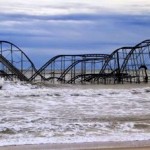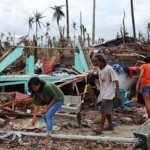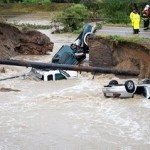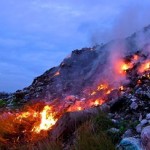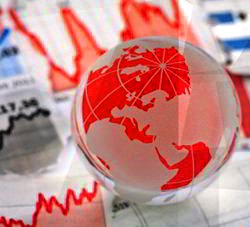 Persistent economic malaise coupled with frequent extreme weather events an increasingly dangerous mix
Persistent economic malaise coupled with frequent extreme weather events an increasingly dangerous mix- National resilience is crucial to tackle unpredictable global threats; new country rating system launched
- Health and hubris, digital wildfires and environmental/economic stress are the three risk cases for 2013
- The report analyses 50 global risks, with breakdowns for China, Middle East/North Africa and Latin America
London, United Kingdom – The world is more at risk as persistent economic weakness saps our ability to tackle environmental challenges, according to the World Economic Forum’s Global Risks 2013 Report.
The report highlights wealth gaps (severe income disparity) followed by unsustainable government debt (chronic fiscal imbalances) as the top two most prevalent risks, in a survey of over 1,000 experts and industry leaders, which reflects a slightly more pessimistic outlook overall for the coming 10 years.
Following a year scarred by extreme weather, from Hurricane Sandy to flooding in China, respondents rated rising greenhouse gas emissions as the third most likely global risk overall, while the failure of climate change adaptation is seen as the environmental risk with the most knock-on effects for the next decade.
“These global risks are essentially a health warning regarding our most critical systems,” warned Lee Howell, the editor of the report and Managing Director at the World Economic Forum. “National resilience to global risks needs to be a priority so that critical systems continue to function despite a major disturbance,” he added.
Axel P. Lehmann, Chief Risk Officer at Zurich Insurance Group, said, “With the growing cost of events like Superstorm Sandy, huge threats to island nations and coastal communities, and no resolution to greenhouse gas emissions, the writing is on the wall. It is time to act.”
Global Risks 2013 Report analyses three major risk cases of concern globally:
1. Health and Hubris
Huge strides forward in health have left the world dangerously complacent. Rising resistance to antibiotics could push overburdened health systems to the brink, while a hyper-connected world allows pandemics to spread. This risk case draws on the connections between antibiotic resistance, chronic disease and the failure of the international intellectual property regime, recommending more international collaboration and different funding models.
2. Economy and Environment under Stress
Urgent socio-economic risks are derailing efforts to tackle climate change challenges. Inherent cognitive biases make the international community reluctant to deal with such a long-term threat, despite recent extreme weather events. At a time when structural changes are happening in the economy and environment, this case focuses on new approaches to make the strategic investments needed to fend off worst-case scenarios for both systems.
John Drzik, Chief Executive Officer of Oliver Wyman Group, a part of Marsh & McLennan Companies, said, “Two storms – environmental and economic – are on a collision course. If we don’t allocate the resources needed to mitigate the rising risk from severe weather events, global prosperity for future generations could be threatened. Political leaders, business leaders and scientists need to come together to manage these complex risks.”
David Cole, Group Chief Risk Officer of Swiss Re, said, “Coping with the economic and climate change crises is unfortunately no longer seen as a continuum, but as opposing choices. The idea has gained ground that we can’t have solutions to both. But we need to go beyond this thinking-in-boxes approach. So because smart risk management is about taking a holistic stance on situations, we should do the same when it comes to the economic and climate change challenges we’re facing.”
3. Digital Wildfires
From the printing press to the Internet, it has always been hard to predict how new technologies might shape society. While in many ways a force for good, the democratization of information can also have volatile and unpredictable consequences, as reflected in the riots provoked by an anti-Islam film on YouTube. As the media’s traditional role as gatekeeper is eroded, this case considers how connectivity enables “digital wildfires” to spread, and asks what can be done to put them out.
In a special report on national resilience, the groundwork is laid for a new country resilience rating, which would allow leaders to benchmark their progress. It is based on the notion that no nation alone can prevent exogenous, global risks occurring, which makes national resilience a crucial first line of defence.
The report as a whole describes 50 global risks and groups them into economic, environmental, geopolitical, societal and technological categories, which respondents were asked to rate in terms of likelihood and impact. The data shows that younger respondents were more concerned by risks than older ones, while women were more pessimistic than men. On a regional basis, experts in North America tended to see risks as more likely than those in other regions.
The report also highlights “X Factors” – emerging concerns which warrant more research. These include the rogue deployment of geo-engineering and brain-altering technologies.
The three risk cases and X Factors will be the focus of special sessions at the World Economic Forum Annual Meeting 2013 in Davos-Klosters, Switzerland, taking place on 23-27 January under the theme “Resilient Dynamism”.
Developed with expert contributions from Marsh & McLennan Companies, Swiss Reinsurance Company, Zurich Insurance Group, the Oxford Martin School (University of Oxford), the National University of Singapore and the Wharton Center for Risk Management (University of Pennsylvania), Global Risks 2013 is the flagship initiative of the World Economic Forum’s Risk Response Network, which provides private and public sector leadership with an independent platform to build resilience by mapping, monitoring and managing global risks.
Source: WEF.


